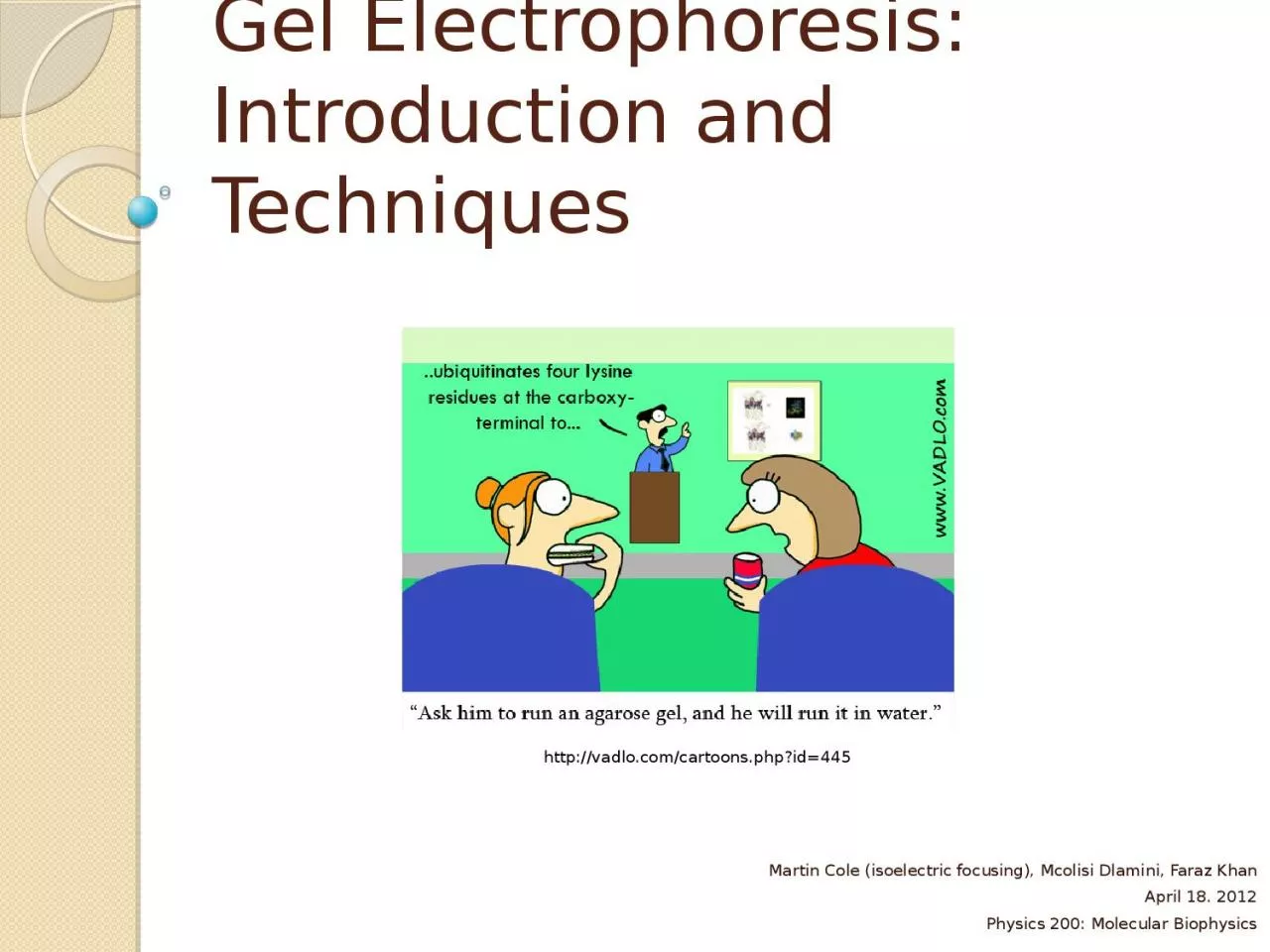

Martin Cole isoelectric focusing Mcolisi Dlamini Faraz Khan April 18 2012 Physics 200 Molecular Biophysics httpvadlocomcartoonsphpid445 What does it do Separation of ID: 917041
Download Presentation The PPT/PDF document "Gel Electrophoresis: Introduction and Te..." is the property of its rightful owner. Permission is granted to download and print the materials on this web site for personal, non-commercial use only, and to display it on your personal computer provided you do not modify the materials and that you retain all copyright notices contained in the materials. By downloading content from our website, you accept the terms of this agreement.
Slide1
Gel Electrophoresis: Introduction and Techniques
Martin Cole (isoelectric focusing), Mcolisi Dlamini, Faraz KhanApril 18. 2012Physics 200: Molecular Biophysics
http://vadlo.com/cartoons.php?id=445
Slide2What does it do?
Separation ofProteinsWestern BlotsSDS-PAGENucleic AcidsNorthern BlotsSouthern BlotsBased onCharge and/orSizeWhat else?Torture Undergrads
Slide31920’s
Erich Huckel and M. Smoluchowski are among the pioneers of electrophoresis. Huckel developed the Huckel equation D. C Henry – provided a theory spherical polyions.1930’sA. Tiselius: Nobel Prize for Chemistry in 1948
Introduced idea of moving boundaries1960’sA. L. Shapiro, E.
Vinuela
and J. V.
Maizel
: developed relationship between electrophoretic migration of proteins and their molecular weight.
Arne Tiselius
Erich
Huckel
History:
Overview
1
Slide4History: Overview
1975Farrell and J. Klose: developed 2D electrophoresis1981J. W. Jorgensen and K. D. Lukas: performed electrophoretic amino acid separation at high efficiency1990B
. L. Karger’s group: discovered a matrix that could be used to separate DNA at high resolution
All
these improvements led to the use of electrophoresis in mapping the human genome.
2000 to
nowwidely
used high-resolution techniques for analytical and preparative separations
Slide5Parts of the System
Gel Support MediumAgarosePolyacrylamide (PA)Native GelsUse PA or StarchNo DenaturantBuffer DC Power Supply
Slide6Basics
www.davidson.edu/academic/biology/courses/molbio/sdspage/sdspage.html
Slide7Molecule in an Electric Field
http://web.ncf.ca/ch865/englishdescr/EFld2Plates.html
E
Q+
QE
f
*u
Slide8Deriving u
a=0, then
INDEX
Q = charge
E = Electric field
m = mass
f = friction coefficient
u = velocity
Slide9Electrophoretic Mobility, μ
Defined as the ratio of the particles velocity to the strength of the driving field.
Therefore,
- Now the velocity depends on the particle properties.
Slide10Units of
μ
So,
Therefore,
http://eculator.com/formula/calculator.do?equation=Capacitance-of-parallel-plate-capacitor&id=41
Slide11Does not correspond to Reality, Not done!
Net charge – due to counterions. Net charge is used instead.
Convection effects – corrected by using gels
https://www.mecheng.osu.edu/cmnf/what-micro-and-nano-fluidics
Slide12Huckel Equation
Used to model electrostatic mobility.
Assume that the particle is a sphere, then Stokes equation applies.
Slide13Electrophoretic Experiments
Method NotesMoving Boundary ElectrophoresisorFree Electrophoresis
Gives mobilityBasis: particles transport properties
Thin layer
Zone
or
Zonal gel Electrophoresis
Uses a matrix as a sieve to separate moleculesBasis: sizeGel: provides stability against convectionElectric
birefringenceNot in syllabus
Slide14Free Electrophoresis
Electrophoretic separation without gel supportCapillary electrophoresisFree Flow Electrophoresishttp://www.youtube.com/watch?feature=player_detailpage&v=lnAcViYsz4g#t=161s
http://www.utwente.nl/ewi/bios/research/micronanofluidics/oldmicro-nanofluidicsprojects/Microfluidic/
Slide15Forces on the Particle
Slide16Retardation Forces
FHDHydrodynamic FrictionFCFCounter ion FlowParticle Travels UpstreamFFAField Asymmetry Effect
http://www.websters-online-dictionary.org/definitions/Electrophoresis
Slide17Electrophoretic Mobility
Smoluchowski Determined another way to view electrophoretic mobility2Only for Thin double layer
http://en.wikipedia.org/wiki/Marian_Smoluchowski
Slide18ξ
(Zeta Potential)Electric potential in the double layer Potential difference between dispersion medium and cage around particleImportant in stability of particles
http://en.wikipedia.org/wiki/Zeta_potential
Slide19Hückel Correction
Smoluchowski did not correct for Debye lengthLength over which charges are screened3Denoted by κ
Slide20http://www.silver-colloids.com/Tutorials/Intro/pcs21.html
Slide21Steady State Electrophoresis
Ions trapped and sealed with semi-permeable membraneElectric FieldFlux of ionsSteady StateFluxes of ion and electric field equal
http://www.spinanalytical.com/mce-products-theory.php
Slide22Steady State Electrophoresis
Slide23Support Medium Electrophoresis
Agarose StarchSDS-PAGENative Set up
http://www.aesociety.org/areas/preparative_gel.php
Slide24Agarose and Starch Gels
AgaroseUsed in DNA separation methodsCan be sued in Large protein separations4Can easily be stored for tagging5Starch Also used to separate non-denatured proteins
http://delliss.people.cofc.edu/virtuallabbook/LoadingGel/LoadingGel.html
Slide25SDS-PAGE6
SDSSodium Dodecyl SulfateDenaturantMovement based only on molecular massβ-mercaptoethanol
PAGEPolyacrylamide
Support
http://www.davidson.edu/academic/biology/courses/molbio/sdspage/sdspage.html
Slide26SDS-PAGE
http://www.youtube.com/watch?v=IWZN_G_pC8U
Slide27Native Gel Conditions
Use PA supportNo DenaturantProtein stays in original conformationProtect from OxidationMovement depends on:Intrinsic Charge7Hydrodynamic Size
http://ccnmtl.columbia.edu/projects/biology/lecture6/index.htm
Slide28Viewing Conditions
Staining depends on type of moleculeView Under UVDNAEthidium BromideGelRedProteinCoomassie Brilliant BlueHorse Radish Peroxidase
http://www.biotium.com/product/product_types/search/price_and_info.asp?item=41003
Slide29References
1 Serdyuk, I., Zaccai, N., & Zaccai, J. (2007). Methods in Molecular Biophysics: Structure, Dynamics, Function. Cambridge: Cambridge University Press.2 von Smoluchowski
, M. (1903). Bulletin International de l'Academi des Sciences de Cracovie
, 184
.
3 Huckel, E. (1924). Physik
. Z. (25), 204.4 Smisek, D., & Hoagland, D. (1989). Agarose Gel Electrophoresis of high molecular weight, synthetic
polyelectrolytes. Macromolecules , 22 (5.), 2270-2277.5 Massachusets
Institute of Technology. (n.d.). Essential Techniques of Molecular Genetics
. Retrieved 2012, from MIT Biology Hypertextbook: http://www.ucl.ac.uk/~ucbhjow/b241/techniques.html6 Voet, D.,
Voet
, J., & Pratt, C. (2008).
Fundamentals of Biochemistry: Life at the Molecular Level.
Hoboken: Wiley
.
7
Arakawa
, T., Philo, J.,
Ejima
, D.,
Tsumoto
, K., &
Arisaka
, F. (2006). Aggregation analysis of therapeutic proteins, part 1: General aspects and techniques for assessment.
Bioprocess International
, 4
(10), 42-49.